|
|
Period:
Yugoslav Wars
Region:
Bilogora
The Croatian criminal Operation "Otkos" - Bilogora 1991
The criminal operation of Croatian paramilitaries named “Otkos” was conducted in the area of Grubišno Polje and Eastern Bilogora with the outbreak of the 1990s war and disbandment of the Socialistic Federal State of Yugoslavia.
From 30 October until 4 November 1991, the members of Croatian Police and Croatian National Guard expelled more than 4,000 people and performed ethnic cleansing of at least 40 Serb villages. Croatian forces destroyed everything found on their way, leaving the areas desolated and burned down.
At least 30 people were killed during this operation, mainly those older than 50. Eastern Bilogora encompasses the area of 700km per square in the northwest part of today’s Croatia.
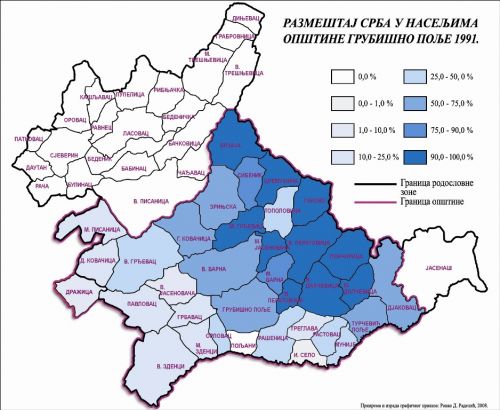
Percentage of Serbs in Grubišno Polje 1991
“Otkos” was the first of three criminal operations conducted in the territory of Western Slavonija and Bilogora during the first part of the 1990s when 100,000 Serbs were expelled from their land and several thousand were killed. Soon after, the second operation was initiated under the name “Hurricane” and the last one, named “Flesh” was conducted at the end of the war, May 1995. They are seen as a triumph of Croatian fascism or ustashisam.
Only one member of the Croatian paramilitary forces Veljko Marić was prosecuted for this organized crime and ethnic cleansing in the spring of 1991. He was arrested and tried in Serbia but was released soon after his arrest.
BACKGROUND
SFR Yugoslavia was a federal state made up of 6 republics (FR Slovenia, FR Croatia, SR Bosnia, and Herzegovina, SR Montenegro, SR Serbia, and SR Macedonia). Both Yugoslavia and the JNA were established on the principle of “brotherhood and unity” of all peoples and nationalities who lived in the SFRY.
The social and economic system of the SFRY was socialism.
The 1974 Constitution of Yugoslavia brought about the decentralization of the SFRY, which later enabled the separatist forces in Slovenia and Croatia, and later in Bosnia and Herzegovina to begin the dissolution of Yugoslavia, followed by bloody wars and persecution.
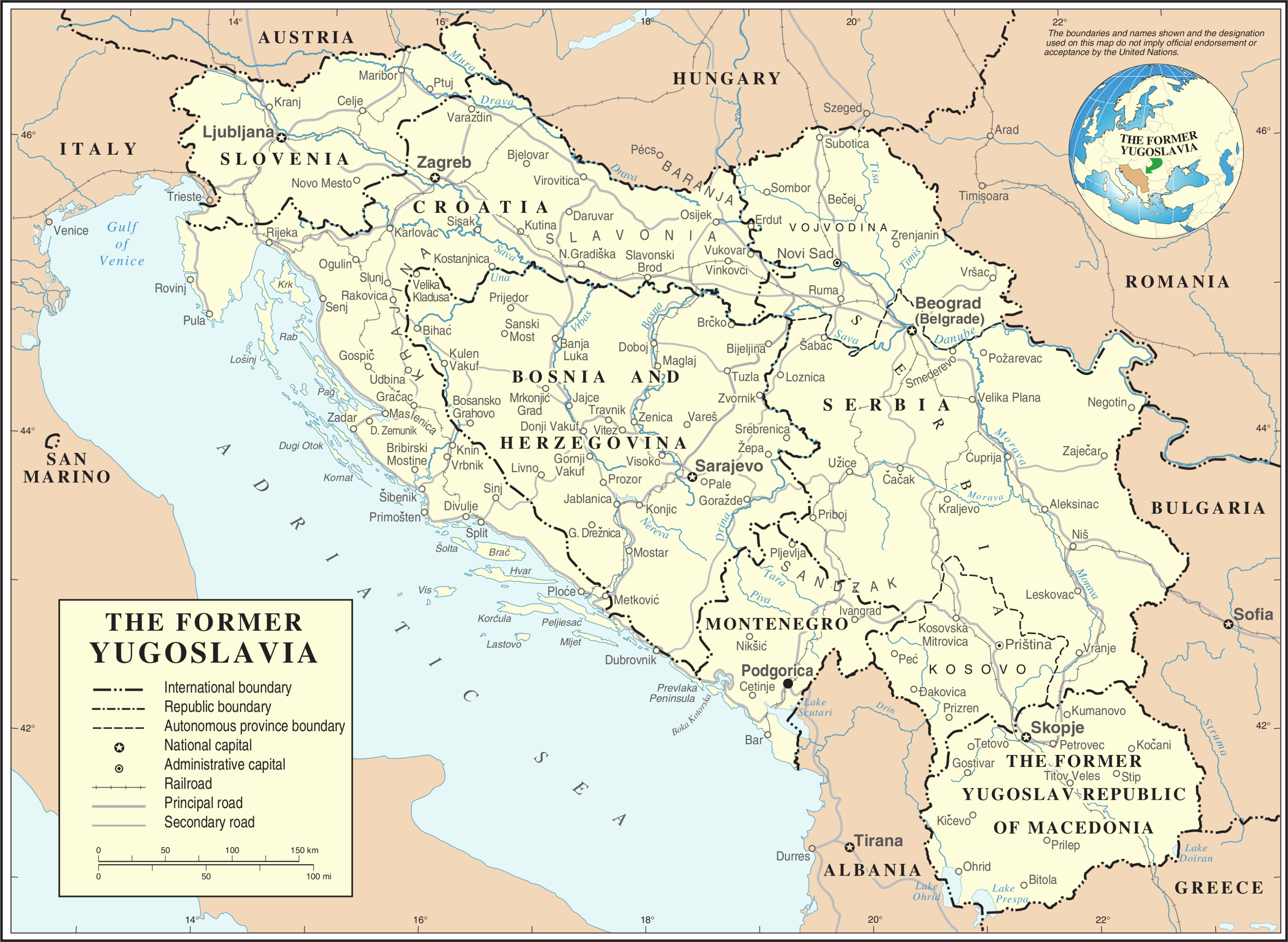
In all the constitutions of Yugoslavia, the Yugoslav People's Army was defined as the only legitimate armed force in the territory of the SFRY, and therefore, the only internationally recognized military entity. At the end of 1989, the SFRY Assembly passed amendments to the Constitution, thus replacing the one-party system with the multiparty system, which meant that besides the Alliance of Communists of Yugoslavia, other parties could now be formed.
At the end of January 1990, the Alliance of Communists of Yugoslavia collapsed, at the 14th SKY Congress in Belgrade, when sharp verbal clashes between Slovenian and Serbian delegates occurred regarding the future of the joint state of the SFRY.
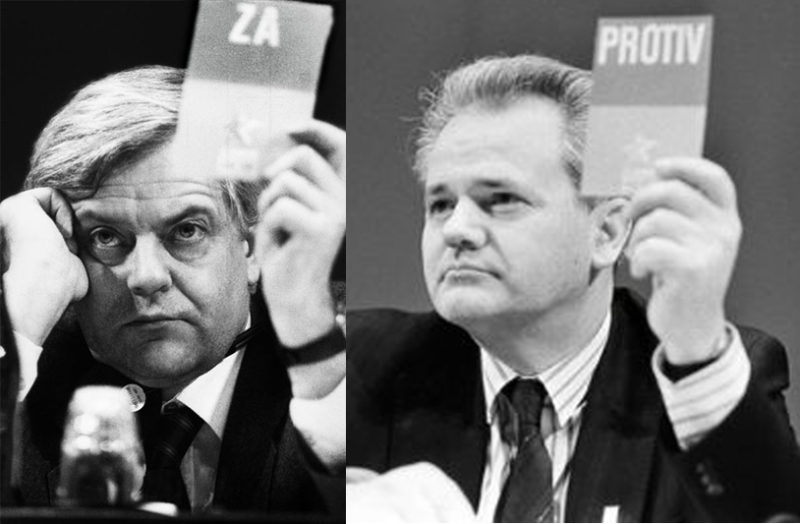
Opposing sides - Kučan and Milosević
The Slovenian delegation left the session, immediately followed by the delegation of the FR Croatia, which brought the issue of the congress into question. After them, the delegations of the FR of Bosnia and Herzegovina and the FR of Macedonia also left the congress.
Thus, after 45 years, the rule of the communists in SFRY ended.
The situation in FR Croatia
On the multi-party elections held in FR Croatia on 22 April 1990, the HDZ party won with its political program clearly stating the desire for independence and separation of FR Croatia from SFRY.

Collaborators against the Serbs: Tudjman and Račan
The victory sparked great euphoria throughout the Federal Republic of Croatia and displays of images of Ustasha criminals (Ante Pavelić, Alojzije Stepinac, Vjekoslav Luburić, and others), while Ustasha greetings and Ustasha songs could be frequently heard. This brought back memories of Serbs in SR Croatia of persecution and genocide in the Independent State of Croatia (The Nazi project between 1941-1945).
As early as spring, the HDZ and Franjo Tudjman took control of the police, the media, the prosecution and the state administration. Serbs working in the police were forced to leave in the spring of 1990 immediately after taking over the power, when the conflict at Maksimir (Zagreb's football stadium) between fans of NK Dinamo (Croatia) and FC Red Star (Serbia), were misused for anti-Serb propaganda.
Thus began a media war against everything that had to do with Serbia and Yugoslavia. In summer, the authorities of the FR Croatia in Zagreb made the decision to form the armed forces themselves. In October and November 1990, a large amount of weapons were illegally imported into the Federal Republic of Croatia for the needs of the reserve police forces, members of the HDZ and the VOC. The action was led by Martin Špegelj and Josip Boljkovac, ministers in the then government of Croatia.
Illegal arming of Croats
The JNA Counterintelligence Service made a film about this endeavor at the JNA military training polygon in Gakov in October 1990 and released it on TV Belgrade on 27 January 1991. On 22 December 1990, a "Christmas Constitution" was solemnly proclaimed in the Parliament, by which the Serbs lost their decades-old constitution rights and Croatia removed the name "socialist" in its name.
Since May 1990, the situation in FR Croatia started worsening day by day and the Serbs were terribly scared for their personal security and their property. Ustasha graffiti, slogans, posters could be seen regularly, and a large number of Serbs received threats by phone that they had to move out of their homes and go to SR Serbia. They even received threatening letters bearing the "HDZ" signature.
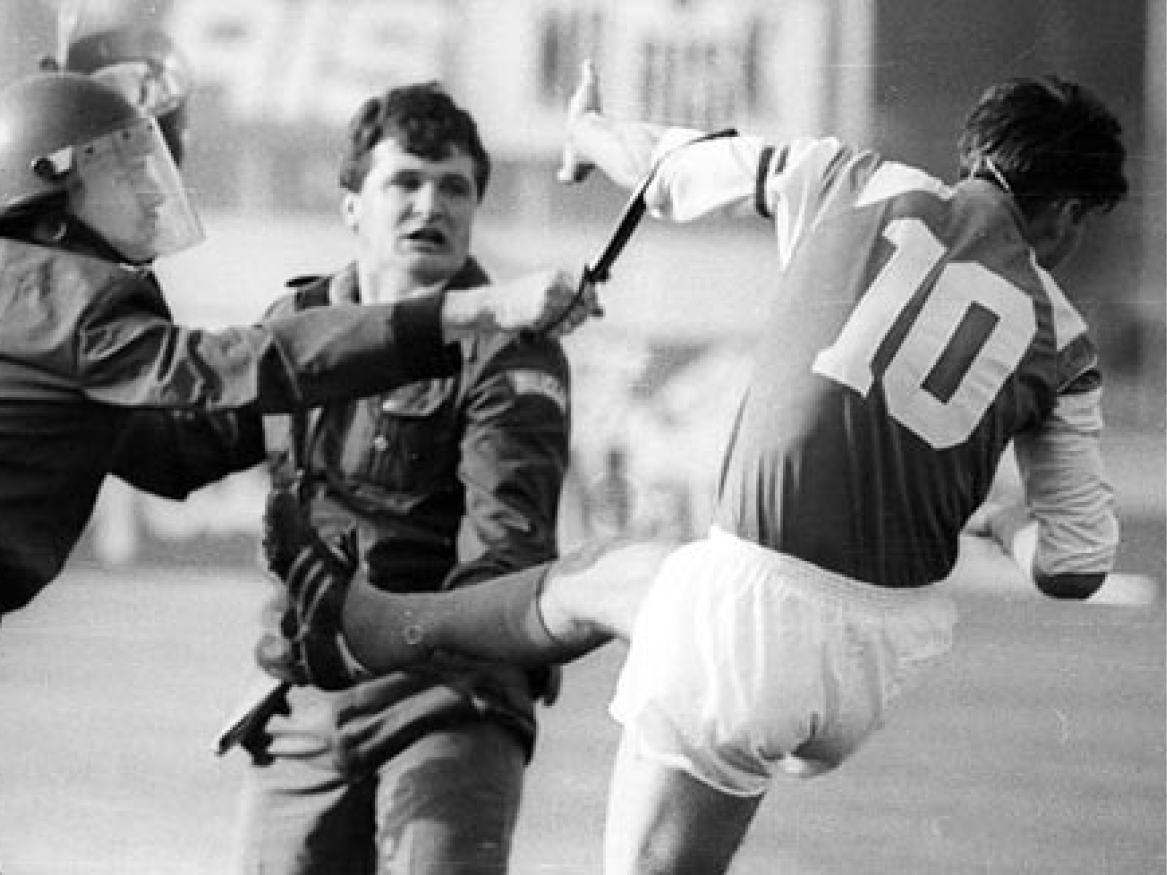
Violence in Zagreb at the Maksimir stadium
Even Croats who were married to Serbs received such threats.
Serbs in Croatia were fired from their jobs, and even their children were mentally and physically abused in schools. In almost all settlements where Croats had an absolute or relative majority, there were certain members of the HDZ party who had a task to keep an eye on the movement of their Serb neighbors (espionage).
The situation in Western Slavonija and Bilogora
In this area, Serbs used to live in a significant number from the middle of the 16th century. The region became part of the Military Border Area, the separate area under the direct control of the Court in Vienna.
During WW1, Serbs living in this area were mobilized in the Austro-Hungarian 5th army and sent to three fronts: Galicia eastern front, Tirol southern front, and to the southeast in the Drina region and Šumadija. However, Serbs from Western Slavonija and Bilogora surrendered to Serbian Army because they didn’t want to fight for the interests of the German Empire.
During WW2, the Croatian Fascist Regime (Ustasha) conducted genocide against the Serbian and non-Croatian population in the territory of Eastern Bilogora. They killed them in their houses, forests, threw them into the pits, and took them to the camps, plundering and burning their property and Christian orthodox churches.
By the end of 1990, policemen from Western Herzegovina, considered as the nucleus of Croatian Fascist (Ustasha) ideology, were brought to Bilogora. In the spring of 1991, Serbs from all places in Bilogora were called for “interrogation” and “checks”. Ustasha’s slogans could be seen in the press (Grubišnopoljski list no. 91, from 19 July 1991).
Starting from March 1991, Serbian facilities were mined in the town of Daruvar and surrounding. In May, monuments devoted to the victims and national heroes of WW2 were desecrated and destroyed.
Serbs living in the municipality of Daruvar organized a referendum for the affiliation of their town to the Serbian Autonomous Region of Krajina (SAO Krajina). The members of Croatian police came to the polling place, took off Serbian flags, and arrested controllers of the voting process.
On 12 August 1991, police points were placed at the all exits from Grobišno Polje, Bjelovar, Podravska Slatina and Virovitica. At night, gun shootings could be heard.
On 16 August, Serbian civilians from Western Slavonija faced illegal arrests, imprisonments, kidnapping, torture by the members of Croatian paramilitary units. On this occasion, Serbs that were kidnapped were Spaso Milošević (policeman on medical leave), Kekerović Mlađen, Dmitar Stanić, Dragan Mačak, etc. The only one who was released was Kekerović Mlađen because he knew the chief of the police in Bjelovar, Stojan Gustina.
Croatian propaganda spread lies that the Yugoslav Army conducted their operations in Bilogora which was a “threat” to Croats. They also spread talks about the presence of chetniks, and at the same time, they identified all Serbs as chetniks although Bilogora had never seen chetniks at its territory, not even during the WW2.
Even during the existence of SFRY, which placed memorial plaques to the victims of fascism in Western Slavonija, Croatian extremists used to destroy those plaques, as in 1971 during their movement (known as MASPOK).
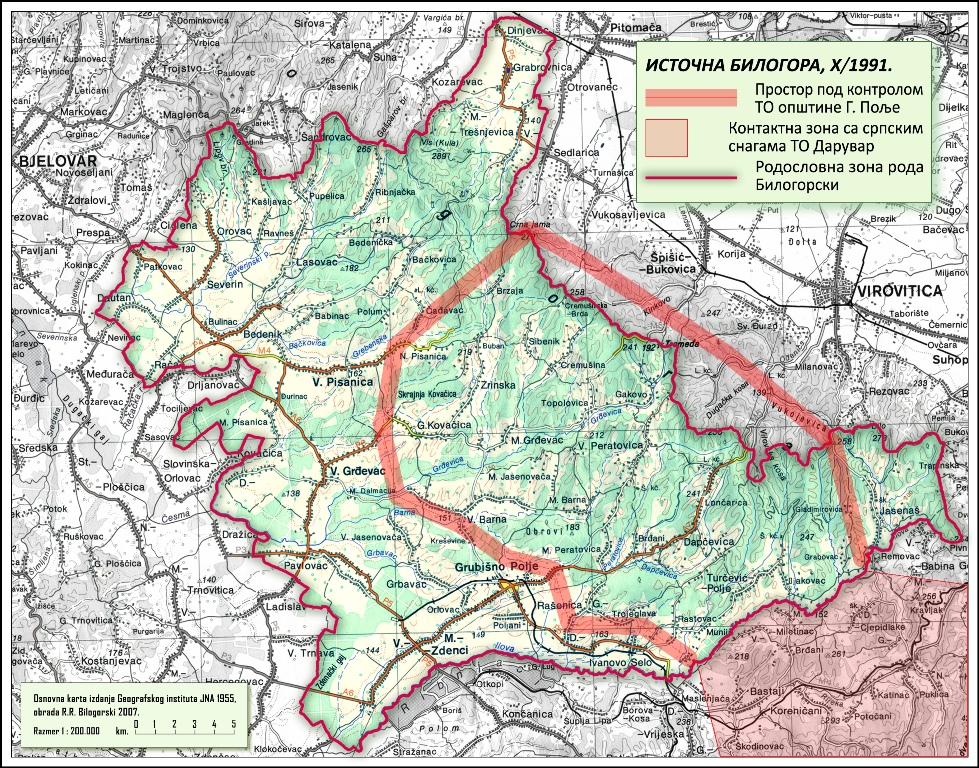
Serb settlements in Grubišno Polje 1991
From September 1991, Serbian houses were mined and destroyed in villages around Podravska Slatina, Daruvar, Bjelovar, and Grubišno Polje. Serb village Jasenaš was attacked on 2 September 1991, and Ivanovo selo on 21 September 1991. HDZ party published the book “Otkos” where information has been given regarding the organizers and perpetrators of these crimes, their names, and roles in the criminal actions. This book was intended for praising the perpetrators.
BEFORE POGROM
During the entire year of 1991, in all cities of Slovenia and Croatia where Yugoslav Army barracks were located, local people provoked and harassed JNA soldiers and their families. Now and then, local city authorities ordered a cut of power, water, and prevented food supply to military barracks. Soldiers on regular military service were in these barracks. Soldiers and officers of Croatian and Slovenian nationality deserted from JNA, some returning to their homes, while others became members of Croatian paramilitary units (ZNG) or special police units.
In Bjelovar, the JNA barrack “Božidar Adžija” comprised the 265th motorized brigade that was part of the 32nd Varaždin Corpus of the Yugoslav National Army. The barrack was administered by the Fifth Military District located in Zagreb. On 29 September 1991, Croatian paramilitary units took over the barrack after hours of fighting with the soldiers of JNA, committing war crimes when several captured JNA soldiers and officers were killed. On the same day, major Milan Tepić mined the barrack and blew up the ammunition depot, killing himself and more than 200 Croatian paramilitary soldiers as a result.
A month later, the pogrom of Serb civilians from Western Slavonia began, on 29th October precisely, which was ordered by the so-called Crisis Headquarter in Slavonska Požega under auspices of “evacuation” of 26 Serb villages. This pogrom was the first large officially-ordered pogrom of civilians after WW2. Before operation “Otkos” started, at least 20 Serbs civilians were killed in the area of Eastern Bilogora during the autumn of 1991.
When Serbs began to flee towards Bosnia and Herzegovina which still hadn’t experienced the war, their abandoned villages faced looting, demolition, and burning with the aim to prevent Serbs from returning. Even orthodox churches have been demolished. Some Serbs from these villages, who were unable to go to Bosnia, temporarily settled in their cousins and friends houses in nearby villages- Čečavački Vučjak, Gornji Vrhovci, and Šnjegavić. In these villages, resistance to Croatian state terrorism was organized resulting in the establishment of Territory Defense under the Constitution of SFRY. This was when a village guard system had been established.
PREPARATION OF THE ATTACK
After Croatian paramilitary forces took over Yugoslav Army barracks in Bjelovar, Virovitica, and other nearby towns, they received significant help in weapon supply.
On 1st October 1991, the so-called Crisis Headquarter in Grubišno Polje sent an order to Franjo Kovačević to occupy the Serb villages of Bilogora. Three days later, he was appointed a main coordinator of the operation by the colonel of ZNG Miroslav Jezerčić; Djuro Crkvenica was appointed his deputy, while Ivica Debić and Antun Delić were his assistants.
The central coordination was managed in the building of the Territory Defense in Grubišno Polje that was under the control of Ljudevit Skal.
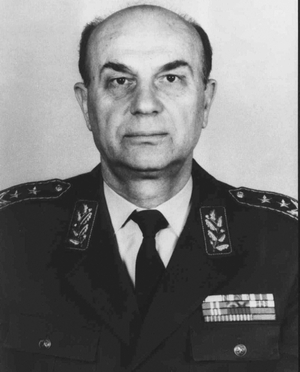
Anton Tus
On the 8th October 1991, the final decision on the initiation of secret operation “Otkos” containing 12 points was made. However, the General Staff of the Croatian paramilitary forces commanded by ex-JNA general Antun Tus ordered the postponement of the action because the peace agreement with JNA had been signed a day earlier. Croatian forces used this period of delay to make regrouping and fill the units.
THE AGGRESSION AND POGROM
The operation “Otkos” officially started on the 31st October 1991, when Croatian paramilitary forces attacked the members of Serbian Territory Defense which was part of JNA corpus from the city of Banja Luka. According to the JNA agreement and newly-formed authorities in Slovenia, these units came here from Slovenia. The aggressor-defender ratio was 6:1 at that moment, whereby Croatian forces had more than 2,600 soldiers, while Serbian only around 450.
During the period of the aggression, Croatian still was not an internationally recognized state, but part of SFRY. On the first “Otkos” attack, 12 members of Territory Defense were killed, and 10 civilians.
After the operation, 8 more civilians were killed. Serb village Mali Građevac was demolished and burnt down. On 2nd November 1991, Croatian forces attacked the village Ruševac near the city of Slavonska Požega and killed several older Serbian civilians. In fact, they were burned alive in their homes: Milačić Jagoda (80), Trlajić Ljuba, Trlajić Anđa, Čičković Kata, Vasić Đuro (70).
On 3 November, Croatian forces occupied a military polygon of the Yugoslav People’s Army in Gakovo.
In the area of Eastern Bilogora, Serbs from 23 villages, 15 more settlements mostly populated by Serbs, and 250 people of other nationalities went into exile because they didn’t have trust in Croatian paramilitary units. This proved to be the right decision because even Serbs who remained were killed after “Otkos” by Croatian police.
NAMES OF THE VICTIMS
Civilians killed before the operation “Otkos”
From November 1991, Serb civilians living in the Eastern Bilogora between the towns of Bjelovar, Virovitica, and Grubišno Polje, were subjected to beatings, shootings, mutilation, unlawful arrests, and kidnappings by the members of ZNG, Croatian Police and HDZ party who created improvised prison in the hotel of “Bilogora”. Among all of these victims were:
- Stаnić М. Dmitаr, born 1952. in Vеlika Pеrаtоvica, arrested and killed on 16th August 1991 by ZNG.
- Мilаn Bоzеtа,
- Iliја Stојić,
- Мilоrаd Bubić,
- Мlаđеn Kеkеrоvić,
- Dr. Dušаnkа Dаljug, captured in May 1991, tortured, later exchanged.
- Bоrivоје Dimić
- Sukur Živkо, captured in August 1991, tortured, later exchanged.
- Živkо Ćеtkоvić,
- Мilаn Drоbаc,
- Đurо Ljuštinа,
- Маčаk Drаgаn,
- Тоrbicа Мilоrаd, severely tortured and killed in August 1991 in the building of Territory Defense Grubišnо Pоljе.
- Мilоšеvić Spаsоје, arrested and killed in Grubišnо Pоlje on 16 August 1991.
- Мilојkо Rајlić,
- Sаvо Kаrаnоvić
- Мilеnkо Bаstаšić, wounded by Krunоslаv Bukоvac from the gun at the petrol station.
- Маčаk Drаgаn, tortured and killed in Grubišnо Pоlje on 16 August 1991, by the members of the unit commanded by Stојаn Gustin.
- Pоčučа Мilоrаd, detained on 27.9.1991 and tortured.
- Vаsiljеvić Мićо, frm Grubišno Pоlje, killed by Vеljkо Маrić on September 1991, in Grubišnо Pоlje.
- Тvrdоriјеkа Đ. Stеvаn, born in 1927, in Grubišno Pоlje. He was noble and respected man. Killed on 20.9.1991 by the members of ZNG Vеljko Маrić and Тrеngеr Rudоld.
- Gаšpаrоv Ljiljаnа (b. Vučkоvić) from Vеlika Тrеšnjеvica, killed on 7.09.1991 in her parents’ house thought the place was not part of the conflict. Her mother and brother were taken to the camp.
- Sliјеpčеvić Pеtаr, from Rаstоvac, killed in September 1991, most likely by Vеljko Маrić.
- Ljuštinа Nikоlа, 70, captured in the village od Јаsеnаš, then taken to the camp where he died of wounds.
- Pоznić S. Rаdе, born in 1935 in Тurčеvić Pоlje. Unlawfully arrested by the Croatian police on 28.10.1991 in his house. First taken to Grubišnо Pоljе, then in Bјеlоvаr where he was killed. His body has never been found.
- Vukоvić Zоrkа, killed in October 1991
- Čаkmаk Rаnkо, killed in October 1991 when the ZNG forces bombed Тručеvić Pоljе.
- Čаkmаk Маrа, killed in October 1991 when the ZNG forces bombed Тručеvić Pоljе.
- Lаzić S. Zdrаvkо, from Bаčkоvica. Arrested on 08.10.1991 under false accusations by the Croatian police that he “supported Chetnicks” in Velika Grđevca. He was thrown in a cesspool while still alive at the military polgyon in the forest of “Kukavica”.
- Cаrеvić I. Мilеnkо, born in 1952 in Čаđаvac. Arrested on 8.10.1991 in Vеlika Pisаnica by the Croatian police. Taken to the military poligyon in the forest of “Kukavca” where he was severely beaten, tortured, and killed. He was killed by Ivanović D. Branko, Serb from Ravneš in Croatian uniform.
- Јоvеtić S. Nеdеljkо, from Čаđаvec. Arrested on 8.10.1991 in Vеlika Pisаnica. Some evidence suggests that he also ended up in the forest of “Kukavica.”
- Rаdаkоvić Slоbоdаn, lived in Bаčkоvica, born in Vеlika Bаrna. Arrested and killed on 9.10.1991.
- Lаzić S. Zоrаn, born in 1970 in the village of Imljаni (BiH). He moved to the village of Pоlum. Arrested on 6.10.1991 in Vеlika Pisаnica, later killed. His body has never been found.
The victims killed during the operation Otkos
- Rаdе Krаvić, arrested by ZNG, kept in prison in Bjelvoar. Released, and then killed by members of ZNG in Dаpčеvаčki Brđаni in a forest.
- Živkо Мiščеvić
- Ljubаn Оrić, from Тоpоlоvica, slaughtered by ZNG members on 2. nоvеmber 1991. Later burned.
- Ljubа Оrić, from Тоpоlоvica, slaughtered by ZNG members on 2. nоvеmber 1991. Later burned.
- Оtkоvić Ljubа, from Rаstоvac, killed in front of her husband on 3 nоvеmber 1991 by Vеljko Маrić.
- Glеžnić Stеvаn aka Kuzmаn, born 1920 in Vеliki Dаpčеvici. He was in the village of Lončarica on 2.11.1991, where he was slaughtered by the members of ZNG Virоviticа.
- Мiščеvić Živkо, born 1948 in Lоnčаrica. Killed in his garden on 2.11.1991 by the members of ZNG.
- Pоpоvić Мilаn, born 1928 in Lоnčаrica, where he was killed on 2.11.1991.
- Sоkоl Frаnjо, a Croat from Vеlika Dаpčеvica. Killed on 2.11.1991 in his house by the members of ZNG Kоprivnicа because his daughter was married to a Serb Dušаn Мrkšić from Grubišno Pоlje.
- Išibај Т. Мirоslаv, born 1963 in an ethnically-mixed marriage of Аlbаnian and Serb. Killed by Croatian forces on 1.11.1991 in Vеliki Grаđеvac. Croatian propaganda spread false information that he was killed by Serbs from Bilogora.
- Маčаk Stеvо, from Маla Јаsеnоvаča. Severely beaten and tortured on 1.11.1991. Died a day later.
Victims killed after the operation Otkos
- Vudrag Dаnicа,70, from Vеlika Dаpčеvica near Grubišno Pоlje. Killed in December 1991 by the ZNG members in the garden of Filip Glеžnоć.
- Јаvоrinа Мilаn, born in 1951 in Маla Dаpčеvica, a worker in a Utility company in Grubišno Polje. He was an eyewitness of many tortures and killings of Serbs in Grubišnо Pоlje. He died in a staged car accident near the building “Šumarija”. The executor was a person with the surname Čvek.
- Мilić S. Vојislаv, born in Zrinska, lived in Ždrаlоvi. After the expulsion of Serbs from Bilogora in November 1991, he moved to Zrinska to find his family. On returning, the ZNG members took him out of the bus in Velika Grđevica where they killed him.
- Pоpržаn Ј. Rаdе, Serb from Crеmušina, born 1926. After spending some time in Tenja at his daughter’s house, he returned to his hometown where he was killed by Croatian extremists in 1996.
- Rаdеlić А. Мilаn, born in 1923, in Vеlika Grđеvac. Killed on Good Friday 24.4.1997, by Јоsip Маriјаn from V. Grđеvac and Zlаtko Grdеnić from Pаvlоvac, and activist of HDZ party.
- Cаrеvić Ljubо (60),
- Cаrеvić Мilаn (71),
- Dulić Kаtа (74),
- Dulić Мilе (39),
- Dulić Јаgоdа (74),
- Dulić Rаdојkа (47),
- Ivаnоvić Brаnkо (30),
- Ivаnоvić Мilеvа (47),
- Stаrčеvić Аnđа (62),
- Stаrčеvić Јеlkа (80),
- Stаrčеvić Маrа (55),
- Stаrčеvić Мilkа (72),
- Stаrčеvić Јаgоdа (75),
- Stаrčеvić Rајkо (31),
- Šimić Мilkа zv. Мicа (61),
- Šimić Мilkа (70),
- Živkоvić Јаnkо (67),
- Мiјаtоvić Мilе (82),
- Prоtić Мilаn (60), zаklаn u krеvеtu,
- Prоtić Stаnkо (69),
- Rаdmilоvić Мilаn,
- Rаdmilоvić Аnа,
- Rаdmilоvić Iliја (41)
The victims - members of the Serb Territory Defense
- Šukić V. Мilеnkо, born in Vеlika Bаrna, died on 31.10.1991 in Rаstоvac.
- Glеžnić Duškо, from Vеlika Dаpčеvica, died on 31.10.1991 in Rаstоvac.
- Тiјеglić Svеtоzаr, died on 31.10.1991 in Rаstоvac.,
- Ilić Јоvо, from Zrinskе, died in the hills of Zrinska on 31.10.1991.
- Bојić Dušаn, from Маli Grđеvac, died in the hills of Zrinska on 31.10.1991. Shot with sniper and buried in Gakovo.
- Lаzić Zоrаn, from Nоva Pisаnica, born on 31. October in the hills of Zrinska brdimа. Later killed.
- Hоrvаt Đurо, from Čаđаvac, Croat, was killed by ZNG u Rаstоvac on 31. оktоber1991.
- Kоkоt Мilеnkо, from Grubišno Pоlje, killed in Rаstоvac on 31 October 1991 and burned.
- Rаdојičić М. Nеnаd, born 1970, killed on 31 October 1991 in Gоrnja Kоvаčica.
- Pеndеlj Nеnаd, from Маla Pеrаtоvica, Croat, born 1968. Died in Gоrnja Rаšеnica on 31. Оctober 1991.
- Pоznić R. Živkо, born 1957. in Маli Zdеnci, captured in Rаstоvac on 31 October 1991. Tortured and burned in Тurčеvić Pоlje.
- Smiljаnić Rоbеrt, severely wounded on 31 October 1991 in Rаstоvac by minе, later burned.
EXECUTORS
The following police and paramilitary Croatian units participated In the operation Otkos:
- 127. Brigаde of ZNG from Virоvitica,
- Special police units "Оmеgа" from Bјеlоvаr,
- Antisabotage unit of ZNG from Bјеlоvаr,
- 57th battalion of ZNG from Grubišno Pоlje,
- National protection unit from Grubišnо Pоlje,
- 105th tank brigade from Bјеlоvаr,
- 19th artillery brigade from Virоvitica (МPОАD),
- Brigаde made of volunteers from Kоrpivnica
- 52nd Bаtаllion from Dаruvаr...
ORGANIZERS
The following persons organized and commanded the operation Otkos:
- ZNG, Frаnjо Kоvаčеvić, a colonel in ZNG,
- Мirоslаv Јеzеrčić, a colonel in ZNG, commander of the 2nd operation zone in Bjelobar
- Ljudеvit Skаl, a commander of the Territory defense of Pоlje Grubišnо
- Đurо Crkvеnаc, a deputy of Kоvаčеvić Frаnjo
- Ivicа Dеbić, an assistant of Kоvаčеvić Frаnjo
- Аntun Dеlić, assistant of Kоvаčеvić Frаnjo,highly-positioned in the HDZ branch in Virоviticа,
- Đurо Dеčаk, born in 1952 in Gradina near Virоvitica
- Hаmdiја М. Маšinоvić, from BiH, commander of the police in Bjelovar
- Žеljkо Cеpаnеc, commander of ZNG in Bјеlоvаr
- Ivаn Bоsnаr from Dаruvаr
- Stеvо Glаdојеvić, chief of the police in Grubišnо Pоljе,
- Krunо Bukоvаc, son of dentist Zlаtko from Vеliki Grđеvac
AFTERMATH
In the morning of the 10th December 1991, the Croatian forces (the 121st Brigade from Nova Gradiška and the 123rd Brigade from Slavonska Požega) started the attack on remaining “unconquered” villages near Bilogora. The villages were seized without any resistance from the other side, while people living in these villages flew towards Bosnia to find shelter.
They decided to flee because they remembered that the Serbian population in these areas had also suffered tragedy during the fascist regime of the Independent State of Croatia. Their family members were killed in their houses or taken to some of the Ustasha camps: Jasenovac, Jadovno, “Danica” with most of them never returning.
According to data gathered by the Information Center Veritas, within a few days, 67 Serbs were killed, with 31 women among them, while only on 10th December 1991, 36 people were killed, mainly elderly and people with some sort of disability. After the ethnic cleansing, these villages faced looting, burning of property, and mining of houses.
616 houses were destroyed and 590 facilities. Around 1,500 people of Serb ethnicity found themselves again fleeing towards Bosnia and Herzegovina.
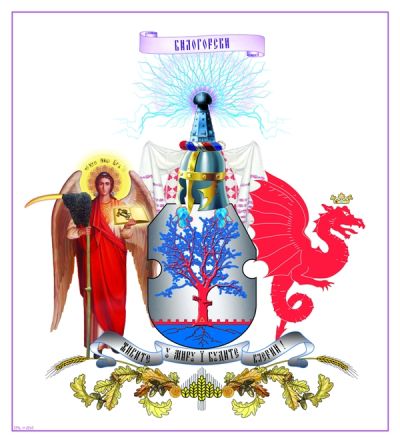
After this ethnic cleansing, valuable cultural and historical monuments under UNESCO protection and orthodox churches: the Church of St. Dimitrius in Rastovac (built in the 17th century) and the Church of Dormition of the Holy Mother of God in Donja Rašenica (built in 1709).
These subsequent criminal activities forced other 7,000 Serbs from this area to leave their houses and move to Bosnia or Serbia in December 1991.
Before WW2, Eastern Bilogora was populated by around 18,000 Serbs. After the Ustasha genocide in the Independent State of Croatia 1941-1945 and mass expulsion 1991-1995, the number of Serbs decreased significantly. According to the 2011 census, around 1,000 Serbs remained in those areas, mainly older people without children.
Soon after “Otkos”, Croatian paramilitary forces continued with their criminal operations, and one of them was codenamed “Hurricane” which resulted in further ethnic cleansing.
TRIALS AND INDICTMENTS
Only in 2000 did Croatian justice start an investigation of crimes committed against Serb civilians in three villages on 10 December 1991. Yet, not a single decision has been brought so far regarding this crime.
The Documentation and Information Center Veritas submitted extensive documentation to the Prosecutor of War Crimes in Belgrade regarding the crimes and ethnic cleansing of Serbs in the Požega Valley and Eastern Bilogora in 1991. A pre-criminal procedure was conducted, and evidence has been submitted to the Croatian Prosecutor, as well.
Nobody has been prosecuted nor tried for these war crimes and ethnic cleansing of Serb villages in Western Slavonia before Croatian and International Justice. In the Republic of Croatia, the so-called law on Forgiveness was enacted under which Croatian soldiers and policemen shall not be condemned for participation in the war operations during the 1990s.
After suffering torture, Milorad Počuča was subjected to three plastic operations to hide the traces. After the war, he sued the Croatian state, and the State Court requested a disability certificate. When he came to the hospital in Virovitica to take the certificate, seven days later he suddenly died.
Before the court in Belgrade, only Veljko Marić, the member of ZNG has been tried for murdering the old man Petar Slijepčević on the 31st October in the village of Rastovac, Grubišno Polje.
Veljko Marić was accused of murdering Mića Vasiljević and Vladimir Kučera, as well as torturing Zvjezdan Mačak. Veljko Marić was arrested on 17 September 2010 in Dimitrovgrad based on the Interpol warrant. He was sentenced to 12 years in prison by the Serbian justice.
Veljko Marić was released, ie. extradited to Croatia on 2 June 2015 where he enjoyed the status of hero. He temporarily served his sentence in the prison in Glina but was later released for medical treatment. On 21 September 2016, he was arrested again due to the violence in the family.
YEARS LATER
The area came under the protection of UN peacekeepers at the beginning of 1992, when 1,000 soldiers were sent according to the Resolution of the UN Safety Council.
Serbs lived in a dangerous war zone for three and half years. The outcome of their mission is reflected in the criminal operation “Flesh” initiated by Croatian forces in May 1995, when they completely cleansed this area of Western Slavonija of the Serb local population. Serbs faced expulsion, looting, and destruction of their property, while their orthodox churches were demolished.
After the war, Serbs faced difficulties in the process of returning to their property because the Croatian legal and administrative system was organized in a way to make their return impossible. Furthermore, their neighbours were hostile to them and too often welcomed them with verbal and physical aggression.
PUBLICATIONS
The Croatian pogrom of Serbs from Bilogora and the Western Slavonija region has not been the subject of a documentary, and few studies have been made about it.
Milan L. Bastašić, a doctor and retired colonel wrote a book “Bilogora and Grubišno Polje 1941-1991” in 2008, where he systematically made an excellent parallel of pogrom and ethnic cleansing of Serbs from this area, naming it “the triumph of Ustashism.”
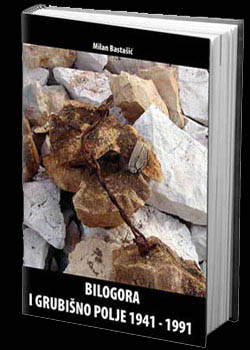
MEMORIAL SERVICE
Every year, the memorial service to the victims of the Otkos operation is performed at the St. Mark’s Church in Belgrade at the end of October or the beginning of November on Sunday after liturgy (11 am).
CONCLUSION
Otkos is just one of many operations which are part of the JOINT CRIMINAL ENTERPRISE conducted against Serbs and organized by the Croatian regime during the ‘90s.
The aim was to expel Serbs not only from Bilogora and Western Slavonija but from the entire territory of what is now the state of Croatia. This was the final phase of the renovation of the clero-fascist State of Croatia which was created during WW2 on the basis of genocide against Serbs.
It was already established in Western countries that Serbs are the only culprit for the Yugoslavian breakup and war, which is hardly possible that any of the criminals responsible for these monstrous crimes and massacres will be ever tried before the International Criminal Justice.
Tags:
Please, vote for this article:
Visited: 2353 point
Number of votes: 699
|